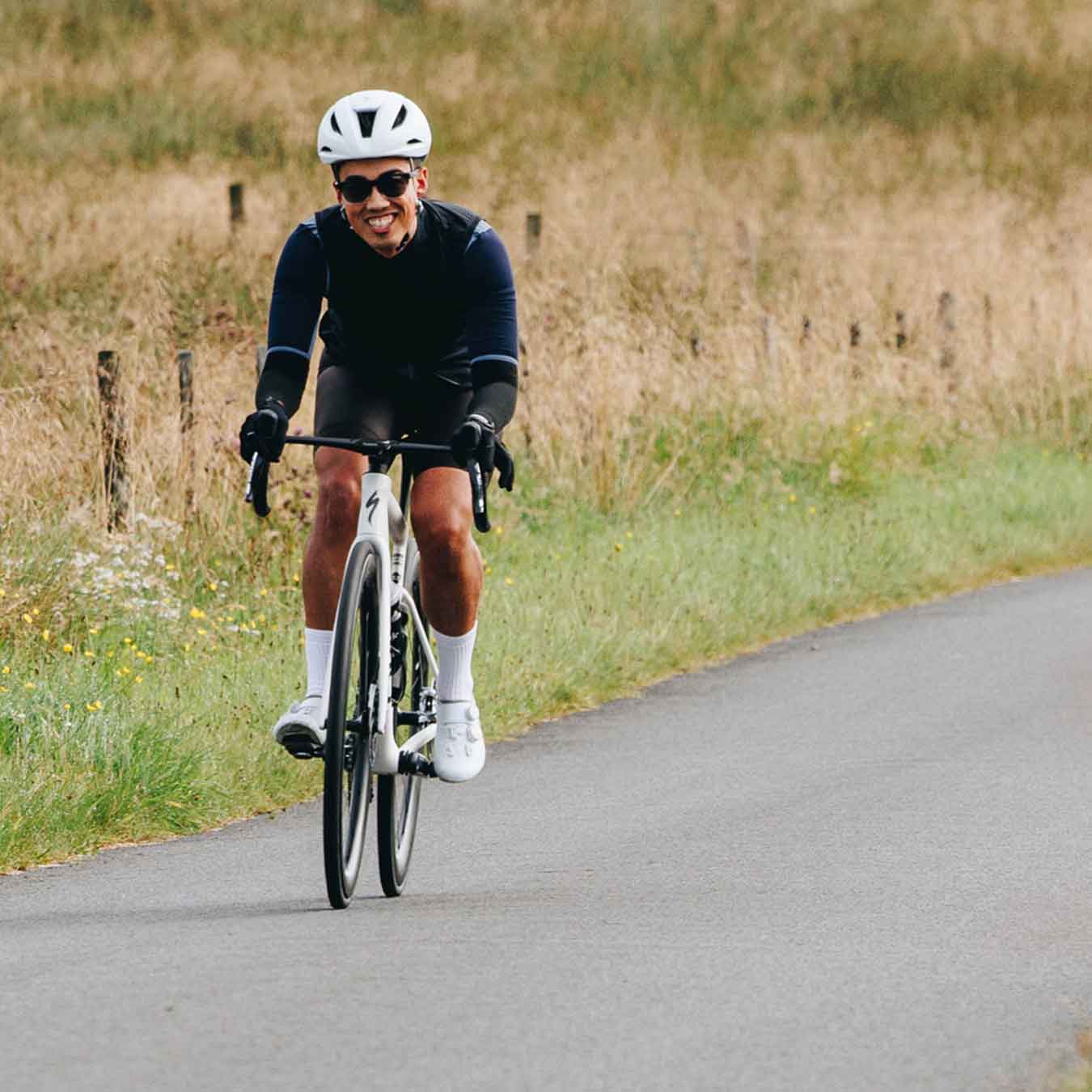Shopping for a new road bike can be as fun as it is nerve-wracking. There are hundreds of options, from practical picks to WorldTour-level bikes ridden by the pros. The sheer number of builds, features, and specifications can confuse even the most avid riders.
Fortunately, we have a team of experts who spend their days obsessing over what exactly makes the best road bike for racing, recreation, and endurance. We tapped them to test this year’s crop of 42 bikes all over the world to help you make the right decision.
At a Glance
- Editors’ Choice: Enve Melee ($11,400)
- Best High-Performance Bike: Factor Ostro Vam ($11,199)
- Best Value: Polygon Strattos S ACX ($2,700)
- Best Under $2,000: Canyon Endurace ($1,699)
- Best Race Road Bike: Specialized Tarmac ($13,000)
- Best Endurance Bike: BMC Roadmachine 01 ($12,999)
- How to Choose a Road Bike
- How We Test
- Meet the Testers
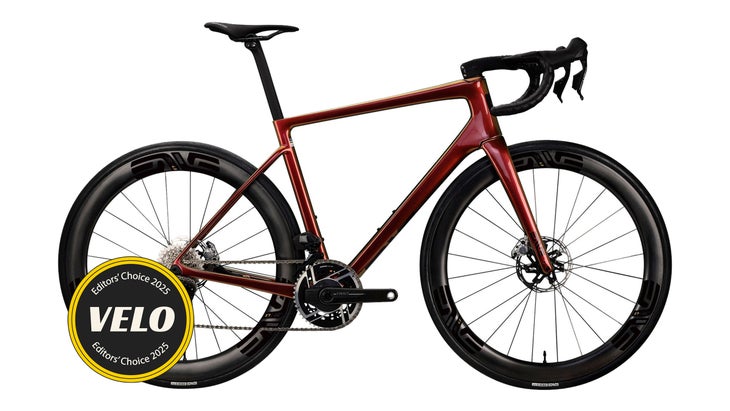
Editors’ Choice
Enve Melee
$4,800 at Competitive Cyclist (frame only) $11,400 at Black Magic Paint (complete bike)
Test bike: Enve Melee SRAM Red AXS
Weight: 16.9 lbs (size 54 cm)
Pros and Cons
⊕ Room for 35 mm tires
⊕ Integrated front end is uncomplicated and modular
⊕ Broad range of drivetrain, fit, and paint options when new
⊗ Heavier than the lightest road bikes
With the Melee—Enve’s first production bike that isn’t custom—the brand’s vision of what a modern road racer looks like is coming into its sharpest focus yet. It’s aerodynamically optimised, lightweight, and designed to go anywhere a modern road cyclist is likely to go. It even stood at the top of a gravel race podium shortly before release.
What makes the Enve Melee stand out is its ability to marry the best parts of a sharp-edged race road bike with the approachability of an endurance bike. Handling is responsive but not razor sharp, and its stiffness ensures it turns in with precision. Best of all, it places the rider in a slightly more upright position making for a more comfortable ride that’s still not sluggish.
At first glance, what stands out about the Enve Melee is its geometry. Enve dropped the top tube and narrowed it dramatically as it approaches the seat tube. Dropping the top tube might enact a small aero penalty, but it also exposes more seatpost for better compliance.
Consider the Melee a semi-custom bike. It starts with a base of seven frame sizes ranging from 47 to 60 centimeters. From there, riders can build the bike to their specifications, so long as they use a wireless SRAM or Campagnolo drivetrain, or a wired Shimano Di2 option.
We’ve spent a lot of time on strictly aero bikes, and the Melee is a sharper tool than those bikes. It feels like a bike that’s ready to respond when you are. It practically begs you to sprint at every opportunity and it takes off at the slightest increase in power. And while its 16.9-pound ready-to-ride weight is a little heavier than you’d expect, the added weight isn’t noticeable—this bike feels fast.
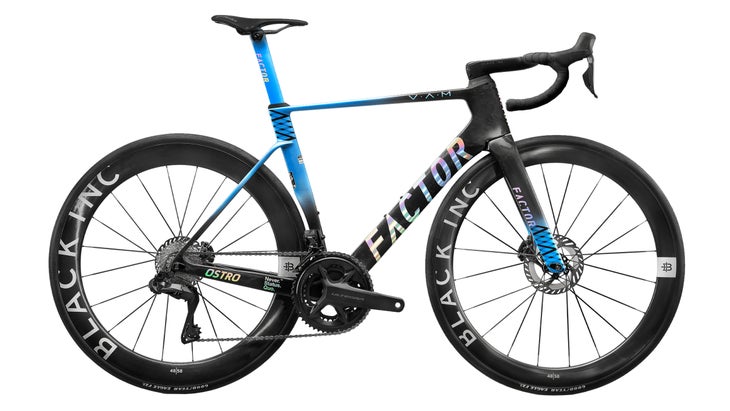
Best High-End Performance Bike
Factor Ostro VAM
Test bike: Factor Ostro VAM Dura-Ace Di2
Weight: 15.2 pounds (size 52 cm)
Pros and Cons
⊕ Top-tier finishing kit
⊕ Razor-sharp handling
⊕ Broad range of drivetrain, fit, and paint options
⊗ Creaky headset
The latest high-end road bikes just look fast. This Factor Ostro VAM is no exception, particularly in the Gloss Chrome colorway we tested. The marbled look of the carbon fiber pops under direct sunlight, while the holographic logos stand out against the otherwise black canvas.
But what makes this bike actually fast is its focus on aerodynamic efficiency in the design, from the narrow profile to the tightly-angled seat stay junction (a design inspired by 1930s Spitfire planes).
Watch: Longterm Review of Factor Ostro VAM
The Factor Ostro VAM feels alive from the first pedal stroke. The low weight of the wheels (1,270 grams, according to Factor) is immediately noticeable, and it allows the bike to get up to speed impressively quick. The bike is also stiff (particularly at the front), making it predictable and easy to manage despite its racy build. That combination of low weight and great lateral stiffness makes the bike feel like a climbing bike.
Another thing we like about the Ostro VAM is the customization options. It comes in a slew of complete builds or as a frame set, but you can also customize seat post setback, stem lengths, and bar widths at every level. Only a select few brands offer that ability at no extra cost. Heck, you can even customize the paint job if you’re willing to shell out extra.
We had few complaints about this bike, just a minor annoyance: The headset was prone to creaking after getting caught in the rain, even when we were diligent about wiping down the bike after a wet ride. We learned to keep the area between the frame and bearing greased, an example of the type of regular maintenance a bike like the Ostro VAM requires to keep it riding smoothly.
There’s no getting around the cost of the Factor Ostro VAM, but the experience feels properly premium to match. The Ostro VAM is one of the sharpest-handling race bikes out there, one that feels as fast on the flats as any race bike we’ve ever ridden.
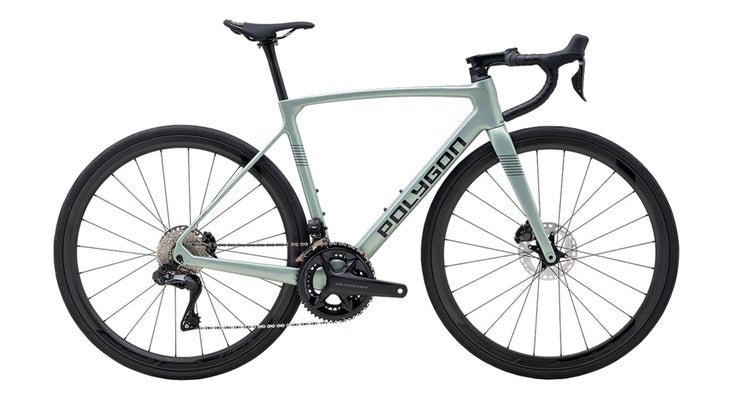
Best Value
Polygon Strattos S ACX
Test bike: Polygon Strattos S8X Ultegra Di2
Weight: 18 lbs (size XS)
Pros and Cons
⊕ Incredible value for money
⊕ Well-mannered handling
⊕ Looks good
⊗ Not an endurance bike as described
⊗ Handlebar is subpar
Good road bikes are expensive—too expensive for many just getting into road cycling. The Polygon Strattos S8X is a refreshing anomaly. Not only does this bike come with a carbon frame, fork, and wheels, it also sports a Shimano Ultegra Di2 drivetrain—all at a price that’s two to three times lower than similar bikes.
With a full carbon frame, mostly internal cable routing, hints of aero tubing, and the clean pearlescent paint scheme, the Strattos S8X looks like a more expensive road bike. The Shimano Ultegra Di2 drivetrain and carbon wheels found on this Strattos S8X are wholly convincing, too. Take a look at the frame as well and you’ll find more boxes ticked.
There’s a Token headset that routes its hoses externally under its stem before routing into the headset upper. The seat post wedge for the 27.2-millimeter round seat post is tucked away into the seat tube cluster. That’s paired with a press-fit bottom PF86 bottom bracket and standard thru-axles, to boot. Even the handlebars are fairly traditional, making this bike relatively friendly to home mechanics.
Our biggest criticism of the Strattos S8X is that it’s not an endurance bike as Polygon advertises. The geometry is tilted towards those who prefer riding in a more aggressive position. Handling is responsive like a race road bike, and its comfort both at the handlebars and at the saddle is far from smooth, thanks partially to a frame that seems focused on speed rather than soaking up any bumps.
We also took issue with the handlebar from Polygon’s house-brand, Entity. There’s nothing wrong with a simple alloy handlebar, but we could not find a position for the bar that worked well. Mercifully, the partially external cable routing means any 31.8 millimeter drop bar can be swapped in without needing expensive labor from cutting and rerouting hoses.
But for this price, it’s easy to overlook those issues. When you consider that most other bikes at this price point lack electronic shifting and carbon wheels—much less Shimano Ultegra Di2—the Strattos S8X feels like a steal.
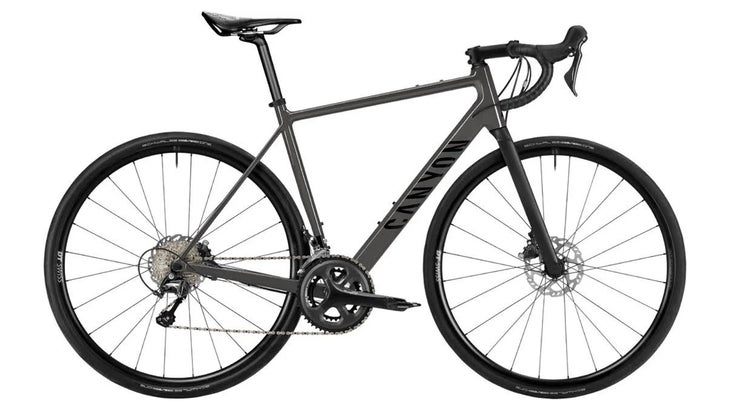
Best Budget Road Bike Under $2,000
Canyon Endurace
Test bike: Canyon Endurace 6 RAW
Weight: 21.3 pounds (size M)
Pros and Cons
⊕ Same fit and handling characteristics of more expensive models
⊕ Reliable components
⊗ Heavy
We’re big fans of the Canyon Endurace platform because it’s an affordable, performance-forward option for burgeoning cyclists.
It comes in four tiers: three carbon fiber models, and an aluminum frame that serves as the entry to the lineup. All share the same geometry that mimic the polished handling and comfortable, upright fit of far pricier bikes. While the Endurace doesn’t come with some features you’ll find on top-tier bikes, it nails the fundamentals.
That includes the Shimano Tiagra 10-speed drivetrain with hydraulic disc brakes, offering both greater stopping power and braking control compared to the cheaper mechanical disc brakes regularly found at this price point. The DT Swiss wheels, Schwalbe 30 millimeter road tires, and the Selle Italia saddle are high-quality and built to last. All this makes the Endurace 6 durable, frill-free, and ready to ride.
Unlike a lot of bikes at this price point, there’s a sense of verve to how it accelerates as you stand up on the pedals. Linewise, there is some polish in how the bike smooths out much of the ruts, cuts, and cracks in the road. This is far from the smoothest road bike on the road, but for a bike in this price range, the Endurace 6 Raw offers impressive performance.
There’s no getting around the direct-to-consumer nature of Canyon, which makes it much tougher to go to your local bike shop for support. Canyon has made some progress here, however, partnering with REI as well as select bike shops to facilitate warranties. This bike isn’t perfect, but it’s a solid option under $2,000.
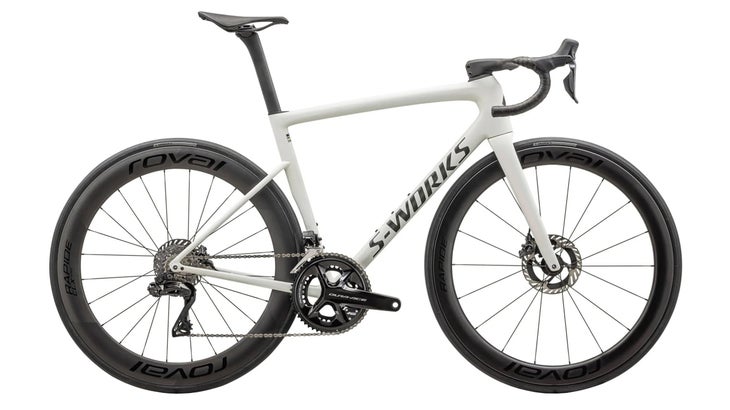
Best Race Road Bike
Specialized Tarmac SL8
Test bike: Specialized Tarmac SL8 Dura-Ace Di2
Weight: 14.72 lbs (size 52 cm)
Pros and Cons
⊕ Lightweight
⊕ Stiffness is confidence-inspiring
⊕ 10R carbon frame is good value
⊗ Top-tier models are expensive
⊗ Not as lively as we’d like
There’s no denying that there’s a lot of hype surrounding the Tarmac SL8 race bike —you’re just as likely to see it at the group ride as on your favorite influencer’s Instagram account—and we’re here to report that the hype is real.
The eighth generation of Specialized’s Tarmac comes with the claims of being lighter, smoother, and stiffer. After testing, we found these claims to be true. The Specialized Tarmac SL8 handles like a Tarmac SL7. That’s no bad thing—Specialized nailed the Tarmac geometry ages ago. There are perhaps edgier race road bikes out there, but the Tarmac feels familiar at the first pedal stroke. Its low weight makes it feel eager up punchy climbs, and the frame’s stiffness provides direct, confidence-inspiring steering. It feels reassuringly sturdy out of the saddle, and stout when pulling on the bars in a sprint. Push the bike around, and it’ll take it.
The Tarmac is perhaps not quite as joyful to ride as something like a Specialized Aethos or an OPEN MIND, bikes that stand out for their springy, lively feel; but the Tarmac sure is speedy, and that’s the goal.
Specialized offers the Tarmac SL8 in an ultra-lux S-Works model (with their lightest-weight 12R carbon frame) and a range of build kits using a less expensive 10R carbon frame. Both are available in myriad drivetrain configurations from SRAM and Shimano and a range of colorways that invoked jealous commentary from cycling friends during testing. While our test bike was a top-spec S-Works model—which nets a top-tier drivetrain and wheels alongside their best frameset—the standard Tarmac frames are still among the lightest road bike frames available.
All of this comes at a price—$14,000, to be exact—which is the biggest drawback to the new Tarmac. But you don’t have to shell out for the top-tier offering—in fact, we recommend models with the less-costly 10R carbon frame, as it offers the same stiffness, compliance, and ride quality as the ultra-luxe S-Works. Those start at $7,000 and still net you a race-ready bike with electronic shifting.
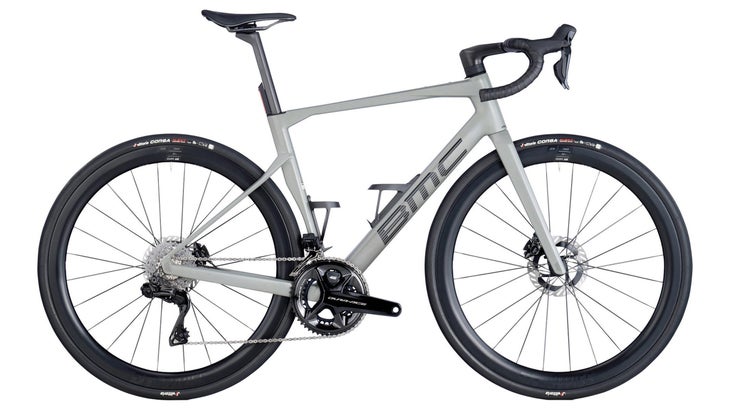
Best Endurance Bike
BMC Roadmachine 01
Test bike: BMC Roadmachine 01 TWO
Weight: 16.3 lbs (7.4 kg)
Pros and Cons
⊕ Excellent spec
⊕ Balanced ride quality
⊕ Handy downtube storage
⊗ Premium pricing across all models
What makes a great endurance road bike? Look no further than the BMC Roadmachine, a bike with an entire lineup from top to bottom that not only feels approachable for cyclists both new and old, but is also a bike that can grow to meet its riders’ needs.
The BMC Roadmachine nails the endurance bike design prompt with its fit geometry. It’s not quite as back-breaking as the race road bikes in this guide, but it also doesn’t position the rider as upright as some other endurance bikes. In terms of handling, the bike feels settled in a straight line while going fast, even over the choppy tarmac that tends to accompany our favorite road rides. This makes it a great option for riders who want to ride long distances on the road without sacrificing comfort.
Best of all, the Roadmachine looks every bit as speedy as the rest of BMC’s speed-focused lineup. The dropped seatstays—a hallmark of BMC’s endurance lineup—add compliance for a smoother experience without dulling road feedback. And while the top-end bikes feature sleek, fully internal cable routing through the stem, the more entry-level models include external brake hose routing that makes the bike easier to maintain and travel with. Regardless of which model you choose, all Roadmachine bikes share the same geometry, the same basic frame design, and a helpful downtube storage hatch for tools and snacks.
We tested the BMC Roadmachine 01 TWO, which is effectively the cream of BMC’s crop (with a price of $12,999 to match). But the inherent goodness of the Roadmachine means riders will find a similarly premium experience across the lineup. For riders who want a high-performance endurance bike that doesn’t compromise on speed, comfort, or aesthetics, this machine stands out as one of the best in its class.
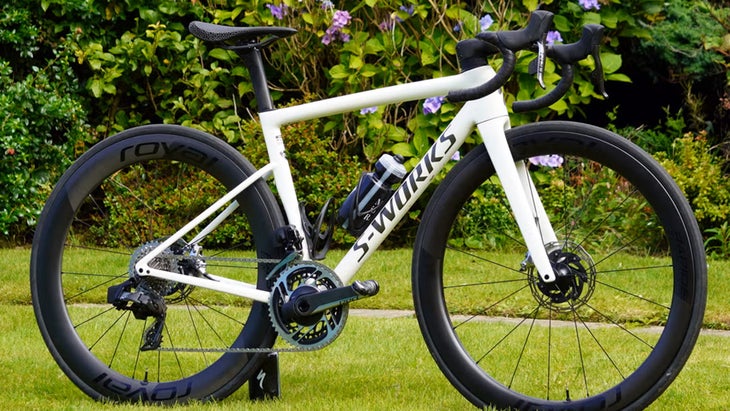
How to Choose a Road Bike
What is the difference between a road bike and a gravel bike?
A road bike is designed first and foremost to be ridden on harder surfaces. That generally means roads and bike paths, but chip-sealed, cracked, and pothole-littered roads can be ridden in a pinch on a road bike, too.
A road bike will typically offer a lightweight frame, wheels, and components to match. Almost every road bike these days features a drop handlebar that curls from the top down, as it offers the rider several hand positions while riding. The tires are almost always narrow, typically ranging from 25 millimeters to 38 millimeters, and have essentially zero tread on them in the name of more efficient riding.
Road bikes don’t come with suspension, but they don’t need it for performance on pavement—modern road bikes are smoother and more comfortable to ride than ever. You’re likely not going to find suspension or even wider tires on a road bike, as that’s the territory of a gravel bike.
A gravel bike, which is designed for riding on dirt and gravel roads first, will prioritize grip and comfort for the seat and handlebars. It will do so at the expense of weight and speed on smooth roads and tarmac. Be sure to see our Best Gravel Bikes of 2024 guide for more information.
If you know you want to ride mostly on-road, and you don’t intend to carry any extra gear, then a road bike is the right choice. Choose the gravel bike if you know you want to ride predominantly gravel and dirt paths, or if you’re uncertain exactly where your riding will take you.
What type of road bike do I need?
There are two broad categories of road bikes: race road bikes and endurance road bikes. Each of those has subcategories that can quickly become confusing.
The type of road bike that is best for the majority of riders is an endurance road bike, occasionally called an all-road bike. An endurance road bike emphasizes comfort and approachable handling. They’re typically easier to manage as the speeds increase and offer up to 38 millimeters of tire clearance to smooth your ride. Further, they’re more likely to have mounts for fenders, racks, or even additional water bottle cages. All-road bikes offer as much as 40 millimeters of tire clearance but retain handling characteristics optimized for riding on roads.
The flashiest road bikes are typically race bikes. They’re more likely to place the rider in a lower, more aerodynamic body position that emphasizes speed over comfort. The frames are lighter and offer stiffer riding to help you go faster. Further, the handling is typically more responsive, sometimes bordering on twitchy. Race road bikes typically feature 25 to 28-millimeter-wide tires, and ditch any feature that doesn’t make the bike easier to ride quickly.
Not all race bikes are the same, however. Some are aero road bikes, which have deeper tubes and rims that prioritize aerodynamics and out-and-out speed. Others are called climbing bikes, which prioritize low weight and stiffness at the expense of aero efficiency.
How much do I need to spend on a road bike?
Most of the bikes we’ve tested qualify as high-end bikes, which can cost as much as a used car. However, there are some fantastic road bikes at a more affordable price point. Budgeting to buy a road bike isn’t just buying the frame. Getting the most out of your road bike requires having the right accessories. At a minimum, you’ll need a quality set of bike lights and a well-fitting helmet in the name of safety. Further, you’ll need to budget for a decent set of pedals, and matching shoes if you want to use clip-in style pedals rather than a more accessible flat pedal.
At the entry-level, one can expect to pay anything between $1,000 to $2,000, depending on what features the bike offers. Clothing, including a jersey, shorts, a helmet, and clip-in shoes can cost anything from $150 to $300. Those accessories we mentioned? Expect to pay $100 to 150 at a minimum, and more depending on your specific needs.
How do I choose the right size road bike?
Road bikes come in a range of sizes to fit riders of all heights. This size range is usually expressed in centimeters, though sometimes you’ll find an XS to XL range.
To figure out the correct size for you, go for a test ride. That means standing over the top tube of the bike (sometimes referred to as a crossbar) to see whether you can comfortably stand with both feet flat on the ground. The top tube can touch you, but the bike is a better fit if it doesn’t.
The right-size road bike will place your arms at roughly a 90-degree angle from your torso without feeling uncomfortable. Your knees will have a slight bend in them at the bottom of your pedal stroke. Most importantly, the bike will feel comfortable to maneuver around.
Of course, the best course of action is to go to a trusted bike shop to have a bike properly sized and fit. Having another set of eyes to help you find the correct size bike will ensure your money is well-spent. They’ll help you determine the right bike for you based on your riding experience, mobility, and needs, and they’ll help you determine proper sizing for features like handlebars, saddles, and even your frame.
How We Test
- Number of Testers: 5
- Number of Bikes Tested: 42
- Longest Test Ride: 142 miles
Five dedicated riders from around the world put 42 bikes through their paces on varied terrain and across hundreds of collective miles—from west Texas to Steamboat Springs, Colorado to Glasgow, Scotland. The road bikes we tested—ranging from entry-level to ProTour worthy—were chosen to encapsulate the best range of bikes on the market today. Yes, we tested road bikes from all the major road bike brands, but we also tested the small brands to cover all bases.
Our test rides included local loops, big days out, group rides, and everything in between. After each ride, we asked each reviewer to judge a bike on the following criteria: Who is it best suited for, and what type of riding was it designed for? What were its strengths, what were its weaknesses, and was there anything that made it stand out above the competition? Every reviewer not only took the time to ride each bike to assess its performance but also built them out of the box and maintained them through weeks of testing to learn more about their ins and outs.
Meet the Testers
Alvin Holbrook
Alvin Holbrook is a tech editor for Velo. He’s been in the bike industry for almost a decade and covers road, gravel, and e-bikes. When he’s not geeking out over bike gear, he uses his background in urban planning to cover stories about active transportation, policy, tech, and infrastructure through the Urbanist Update series. He lives in San Antonio, Texas with his wife and an ever-growing stable of bikes and kitchen utensils.
Josh Ross
Josh Ross is a senior tech editor for Velo. He hails from the Pacific Northwest, but when it’s time to ride, hot and dry is better than cold and wet. He will happily talk for hours about the minutiae of cycling tech but understands most people just want things to work. He is a road cyclist at heart and doesn’t care much if those roads are paved, dirt, or digital. Although he rarely races, if you ask him to ride from sunrise to sunset, and beyond, the answer is always “yes.”
More Gear Reviews
The Best Gravel Bikes of 2025
The Best Bike Racks
The Best Bike Helmets


